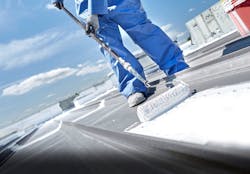Don’t Replace—Repair! Exploring the Benefits of Roof Restoration
The past two years have plunged the economy into uncertainty, creating hard times for families and a noticeable shift in the roofing business landscape. Across the globe, organizations from all industries are looking at how they can cut costs to future-proof their businesses and make better financial decisions.
This is also true for those of us working in the construction industry, as we are subject to the constant fluctuation in prices and availability of materials and labor caused by the ongoing global supply chain crisis.
It’s also true for building owners, who want long-term value for money from their buildings.
So, with this in mind, how do we navigate these unprecedented times and make the right financial decisions? Errol Bull, technical expert for GE branded silicone sealants, discusses how restoring roofs with silicone coatings, rather than replacing them, can bring a range of benefits to building owners from a cost, sustainability and practicality perspective.
Steps Towards Sustainability
Sustainability is everywhere, and there is increasing pressure on businesses and individuals to showcase what they are doing to reduce their carbon footprint, lower waste and achieve a greener future.
This includes building owners. New legislation and concerns about the environment and climate change are driving building owners across the country to actively improve the performance, energy efficiency and environmental credentials of their projects. Sustainability has long been synonymous with expensive, but in reality, some of the most sustainable solutions are often the most cost-effective.
This is especially true when it comes to the roof.
From extreme weather through to general wear and tear, roofs are expected to endure a lot and are a key part of a building’s longevity and successful performance.
Although it may be tempting to replace the entire roof following identification of deterioration, restoration is a much more sustainable and cost-friendly alternative. Done in the right way, it can add decades to the life of a roof, at a fraction of the cost of full replacement.
For example, the cost to tear off an existing roof and implement a new TPO, PVC, mod bit or metal roof can set building owners back as much as $1,500 a square foot, which is a huge drain on budgets.
In addition to being cheaper, opting to repair is also an effective way to reduce the carbon footprint of a project. This is because it significantly delays, and over time reduces, the contribution of expended roofing materials to landfill.
Waste is a big issue in the construction world and one of the main hurdles towards achieving real sustainability, as it’s estimated that 40% of all CO2 emissions are being generated from waste in landfill sites. Therefore, making the decision to repair, rather than replace, can be an effective solution.
Cool Roofs and Sustainability
Energy efficiency is integral to sustainability.
Using the right roofing coating can improve insulation and assist in controlling internal temperatures. This makes a noticeable difference to the temperature and internal comfort of a building and can reduce the need for air conditioning.
In fact, studies have revealed that a cool roof can reduce energy used by air conditioning by 8–48 kWh/m2, the hours of discomfort by up to 100% and the maximum temperature by 2.2 to 6.7 degrees F. (1.2 to 3.7 degrees C.), depending on the climate.
Given that energy prices are on the rise across the globe, it’s important that roofing contractors and building owners identify and implement more energy-efficient ways to both build and maintain their projects.
A cool roof reflects more sunlight and absorbs significantly less heat than a conventional, dark colored roof. Although reflective tiles, shingles, and sheet covers are all viable ways of achieving this, a popular choice is by applying a cool roof coating.
These are typically highly reflective and white in color and can be applied to both new builds and existing buildings. Their heat reflective qualities mean they control temperatures and reduce the need for air conditioning.
A reflective roof coating can also minimize the harmful damage caused by UV exposure which in turn prolongs the effective service life of these roofs—making it great for buildings based in sunny, warm climates which need to perform in extreme heat.
Cutting Carbon Emissions
Using less energy for temperature control can help to reduce the carbon footprint of a building, which can have a hugely positive effect.
When thinking about carbon emissions, it’s helpful to consider your building’s collective environmental impact. Hashem Akbari, the Heat Island Group’s lead scientist and a professor of Building, Civil and Environmental Engineering at Montreal’s Concordia University, for example, calculated that if every building in every city in the world switched to a reflective white roof, the difference would offset the emissions from the equivalent of 600 million cars!
A cool roof can also reduce what is known as the urban heat island effect, in which cities are warmer than rural areas— leading to less energy use, fewer pollutants from power sources and lower smog levels.
This is a remarkable change and would make a significant impact in the fight against climate change. So, while applying a low-VOC (low volatile organic compounds) cool roof solution can improve the environment inside a building, it can also deliver benefits to the wider environment and is an effective way to meet current and future energy savings standards.
Spotlight On: Silicone Coatings
Though reflective tiles, shingles and sheet covers are good candidates for protecting your project, silicone coatings can offer several advantages, including cost, lifespan and performance.
Their strong, inorganic chemical bonds within their structures make them inherently resistant to breakdown under UV light.
This allows them to maintain their flexibility and water resistance for the entire time they are in use—a bonus for buildings set against challenging weather conditions. From rain and wind through to snow and sun, silicone coatings can help to protect a roof now and for decades to come.
Repair and Restore—Well Into the Future
When it comes to roof restoration, it’s understandable to be anxious about the possibility of future repairs and those associated costs.
However, an effective repair, completed using the right products by a good roof coating provider, can offer a truly long-term solution, measured in decades.
Taking into consideration the unstable economy and increasingly stringent sustainability regulations, restoring a roof, as opposed to replacing it, is a cost-effective and practical solution that is much kinder to the environment.
About the Author:
Errol Bull, P.E., CSI, is an architectural engineer and technical services manager for Momentive Performance Materials Inc.
About the Author

Contributed Author
BUILDINGS partners with industry experts to bring you contributed content covering the hot topics for building owners and facility professionals.
